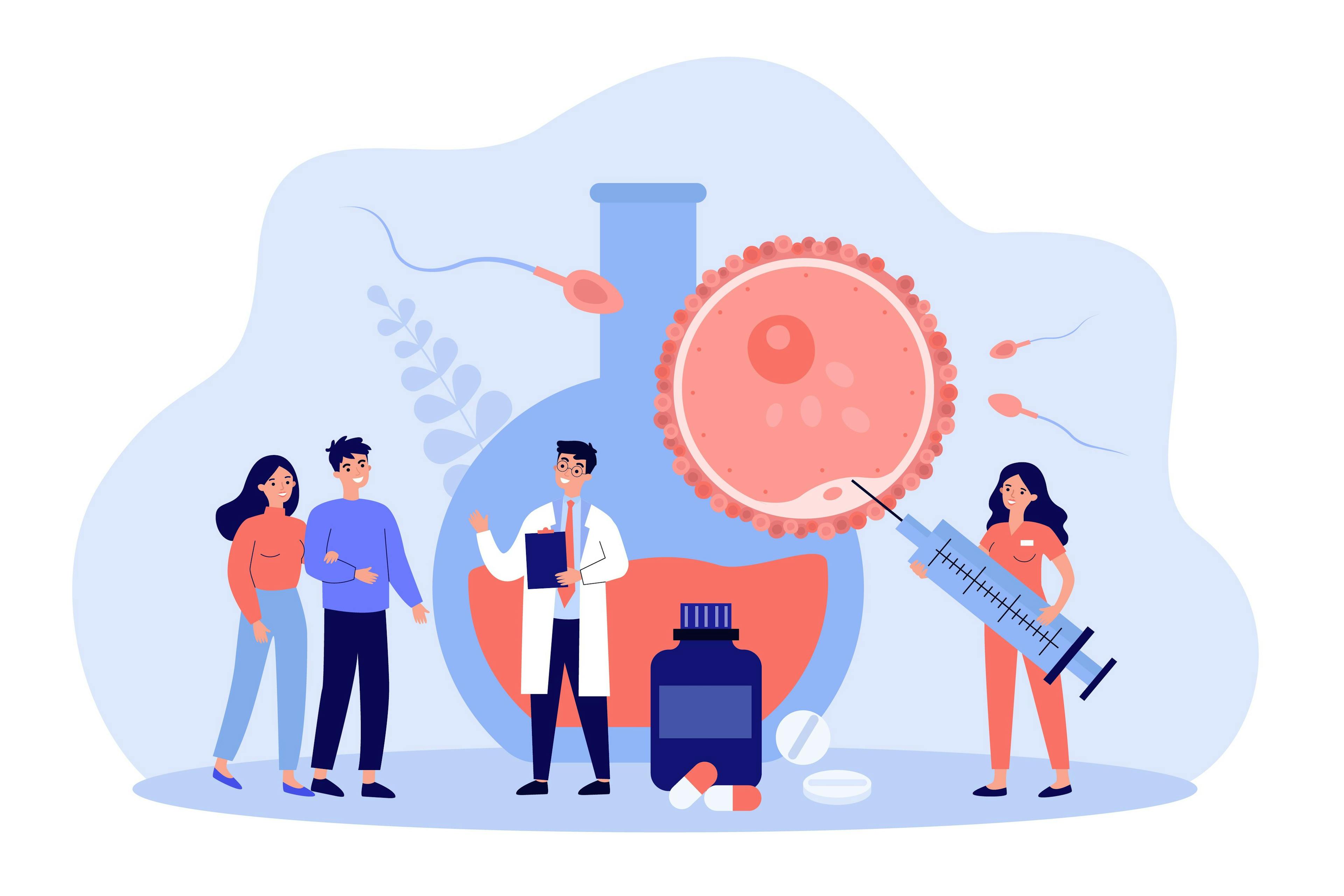Call us today on +44 7897 035438
Understanding IVF Risks
Fertility treatments like IVF have revolutionised reproductive medicine, helping millions of people achieve their dreams of parenthood. IVF is known for being very safe, but like any medical procedure, there are some risks and considerations for you to understand ahead of starting treatment. On this page, we explore the risks of assisted reproductive technology (ART).

IVF: risks and complications
The IVF procedure is relatively straightforward. Fertility medication is used to stimulate a woman’s ovaries so that she can produce multiple eggs. These are collected and fertilised in a lab, in hopes of creating healthy embryos. When the time is right, an embryo is selected and transferred to a woman’s uterus.
IVF is considered very safe: women who have IVF are no more likely to experience issues than those who conceive naturally. Still, like other medical procedures, there are some side effects and risks that you should be aware of.
The individual risk does vary according to factors like age, fertility history and preexisting conditions. Your fertility specialist will assess these carefully within your care in order to reduce all risks as much as possible.
Multiple pregnancy
The biggest risk of fertility treatment is multiple pregnancy, when a woman carries more than one foetus in a single pregnancy. The most well-known type is twins, but there can also be triplets, quadruplets, and more, depending on how many foetuses there are.
Multiple pregnancies are joyous events for many families. Most women carrying twins, triplets or more will go on to have healthy pregnancies and babies. But the pregnancy itself can be more complicated, resulting in careful monitoring, specialised medical care, and more support.
Women carrying multiple pregnancies tend to have an increased risk of:
Gestational diabetes, a condition that affects blood sugar levels during pregnancy
Hypertension (high blood pressure), also known as gestational hypertension or preeclampsia)
Stronger pregnancy symptoms, such as fatigue, ankle swelling, varicose veins and backaches
Excessive weight gain, which can lead to postpartum weight retention and long-term health issues
Anaemia (iron deficiency), which can cause fatigue and weakness
Caesarean section (C-Section), due to factors like the higher risk of complications during labour. Women are usually advised to give birth before their due date
Intrahepatic cholestasis of pregnancy (ICP), a potentially serious liver disorder
Blood clots like deep vein thrombosis (DVT)
Growth problems for the baby
Premature birth (when babies are born before 37 weeks). Preterm infants can face a range of health issues due to their underdevelopment, and are more likely to require care in a neonatal intensive care unit (NICU)
Twin-to-twin transfusion syndrome (TTTS), where the blood flow between the twins is unbalanced, potentially creating complications for both
Baby loss. Due to the various complications multiple pregnancies can pose, they are sadly more likely to end in loss
Mothers expecting multiples will receive tailored care and monitoring to manage and mitigate as many risks as possible.
Risk of multiple pregnancy with IVF
The risk of multiple pregnancy is known to be higher within IVF treatment, but that’s not the full picture: a notable factor for the higher risk is the transfer of multiple embryos in an IVF cycle, a practice that’s now rare in the UK.
Because of the risks multiple pregnancy poses on mother and baby, fertility professionals have made big efforts to lower the rate through time. Organisations like the HFEA helped to decrease the UK’s average multiple birth rate from from around 28% in the 1990s to 6% in 2019.
With time, we’ve also gotten very good at selecting healthy embryos, meaning there is less cause to transfer multiple embryos. Nowadays, unless there’s a specific reason, doctors in the UK will transfer just one embryo, lowering the overall risk of multiple pregnancy.
Ovarian hyperstimulation syndrome (OHSS)
Rarely, the side effects from fertility drugs can be serious. In OHSS, a woman reacts too strongly to fertility medication, causing pain and discomfort. Around one third of women will experience mild OHSS, which can be treated at home. Very rarely (in less than .1% of cycles), a woman will develop a severe, potentially life-threatening case which requires medical attention. Your doctor will tell you exactly what to watch out for and give you plenty of information, so you’ll know what to do if you experience any worrying symptoms.
As we’ve learned more about what causes OHSS, doctors have become very skilled at preventing it. If you’re thought to be at a higher risk than normal, your team will likely change protocol or add extra monitoring, to ensure a serious risk is as low as possible.
Ectopic pregnancy
An ectopic pregnancy is one that occurs outside the uterus, most commonly in the fallopian tube. The risk is slightly higher if you have IVF.
Symptoms usually develop between the fourth and twelfth week of pregnancy, and may include pelvic and stomach pain followed by vaginal bleeding or dark vaginal discharge.
Not all ectopic pregnancies will cause symptoms, and it’s common to detect them only in a routine pregnancy scan. That said, ectopic pregnancies can be very serious, so it’s important that you tell your doctor straight away if you’re experiencing symptoms after IVF and a positive pregnancy test.
Age and increased risks
IVF success rates decline with a woman’s age. Sadly, general risks like miscarriage, gestational diabetes and ectopic pregnancies also rise as a woman gets older. While rare, the risk of birth defects increases with a woman’s age as well.
A number of add-on embryo screening tests are available to check for the chromosomal abnormalities thought to cause fertility issues in older women. The tests involve removing a small number of cells from an embryo and studying the DNA for abnormalities.
Pre-implantation genetic testing for aneuploidy (PGT-A) is one example of embryo screening. The test is sometimes recommended to women over 37, due to the increased risk of chromosomal abnormalities after this age. A fertility doctor may also suggest a PGT-A test if there is a history of miscarriage, or following a series of IVF cycles that haven’t worked. Unfortunately, it’s important to note that even with a PGT-A test, there are no guarantees.
If you want to know more about PGT-A you can have a look at our post here.
Using donor eggs may also help to mitigate risk in older women, as younger eggs are linked to a lower rate of chromosomal abnormalities.
Talking to your team
Throughout your treatment, risks and side effects will be discussed in detail, so you have the chance to ask about any concerns you may have. We’ll also be on call seven days a week in case you have other questions.
Thinking about risks can feel overwhelming. Taking a step back, it may help to remember that the UK’s leading fertility bodies consider fertility treatment very safe, and most individuals will have no issues with their health.
That said, don’t hesitate to drop us a line if you have any questions, big or small. Our phone line and live chat are a tap away, and we’d be happy to answer any queries you may have.
References
(n.d.). Risks of fertility treatment. HFEA.
https://www.hfea.gov.uk/treatments/explore-all-treatments/risks-of-fertility-treatment/
(n.d.). Multiple pregnancy. Tommy’s. https://www.tommys.org/pregnancy-information/im-pregnant/multiple-pregnancy
(n.d.). Multiple births in fertility treatment 2019. HFEA (2022).
(n.d.). State of the fertility sector 2021/22. HFEA (2022).
(n.d.). Risks. NHS.

Written by Giulia Sciota
WriterKeep reading
Why Apricity
Preserve Fertility
Fertility Treatments
Egg Donation
Ⓒ Apricity Fertility UK Limited. All rights reserved


